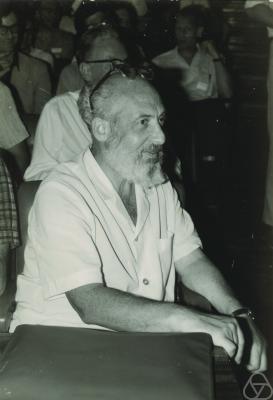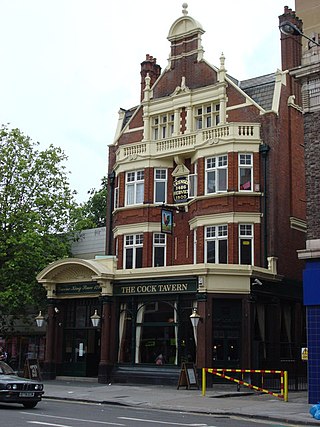Related Research Articles

Category theory is a general theory of mathematical structures and their relations that was introduced by Samuel Eilenberg and Saunders Mac Lane in the middle of the 20th century in their foundational work on algebraic topology. Nowadays, category theory is used in almost all areas of mathematics, and in some areas of computer science. In particular, many constructions of new mathematical objects from previous ones, that appear similarly in several contexts are conveniently expressed and unified in terms of categories. Examples include quotient spaces, direct products, completion, and duality.

The IBM 3270 is a family of block oriented display and printer computer terminals introduced by IBM in 1971 and normally used to communicate with IBM mainframes. The 3270 was the successor to the IBM 2260 display terminal. Due to the text color on the original models, these terminals are informally known as green screen terminals. Unlike a character-oriented terminal, the 3270 minimizes the number of I/O interrupts required by transferring large blocks of data known as data streams, and uses a high speed proprietary communications interface, using coaxial cable.

Enochian is an occult constructed language — said by its originators to have been received from angels — recorded in the private journals of John Dee and his colleague Edward Kelley in late 16th-century England. Kelley was a scryer who worked with Dee in his magical investigations. The language is integral to the practice of Enochian magic.
An application layer is an abstraction layer that specifies the shared communications protocols and interface methods used by hosts in a communications network. An application layer abstraction is specified in both the Internet Protocol Suite (TCP/IP) and the OSI model. Although both models use the same term for their respective highest-level layer, the detailed definitions and purposes are different.

The Personal System/2 or PS/2 is IBM's second generation of personal computers. Released in 1987, it officially replaced the IBM PC, XT, AT, and PC Convertible in IBM's lineup. Many of the PS/2's innovations, such as the 16550 UART, 1440 KB 3.5-inch floppy disk format, 72-pin SIMMs, the PS/2 port, and the VGA video standard, went on to become standards in the broader PC market.
VxD is the device driver model used in Microsoft Windows/386 2.x, the 386 enhanced mode of Windows 3.x, Windows 9x, and to some extent also by the Novell DOS 7, OpenDOS 7.01, and DR-DOS 7.02 multitasker (TASKMGR). VxDs have access to the memory of the kernel and all running processes, as well as raw access to the hardware. Starting with Windows 98, Windows Driver Model was the recommended driver model to write drivers for, with the VxD driver model still being supported for backward compatibility, until Windows Me.
In computer science, communicating sequential processes (CSP) is a formal language for describing patterns of interaction in concurrent systems. It is a member of the family of mathematical theories of concurrency known as process algebras, or process calculi, based on message passing via channels. CSP was highly influential in the design of the occam programming language and also influenced the design of programming languages such as Limbo, RaftLib, Erlang, Go, Crystal, and Clojure's core.async.

Samuel Eilenberg was a Polish-American mathematician who co-founded category theory and homological algebra.
In mathematics, specifically algebraic topology, an Eilenberg–MacLane space is a topological space with a single nontrivial homotopy group.
The X-machine (XM) is a theoretical model of computation introduced by Samuel Eilenberg in 1974. The X in "X-machine" represents the fundamental data type on which the machine operates; for example, a machine that operates on databases would be a database-machine. The X-machine model is structurally the same as the finite-state machine, except that the symbols used to label the machine's transitions denote relations of type X→X. Crossing a transition is equivalent to applying the relation that labels it, and traversing a path in the machine corresponds to applying all the associated relations, one after the other.

A Kahn process network is a distributed model of computation in which a group of deterministic sequential processes communicate through unbounded first in, first out channels. The model requires that reading from a channel is blocking while writing is non-blocking. Due to these key restrictions, the resulting process network exhibits deterministic behavior that does not depend on the timing of computation nor on communication delays.
In computer programming, flow-based programming (FBP) is a programming paradigm that defines applications as networks of "black box" processes, which exchange data across predefined connections by message passing, where the connections are specified externally to the processes. These black box processes can be reconnected endlessly to form different applications without having to be changed internally. FBP is thus naturally component-oriented.
In programming and software design, an event is an action or occurrence recognized by software, often originating asynchronously from the external environment, that may be handled by the software. Computer events can be generated or triggered by the system, by the user, or in other ways. Typically, events are handled synchronously with the program flow; that is, the software may have one or more dedicated places where events are handled, frequently an event loop.
In mathematics, specifically in algebraic topology, the Eilenberg–Zilber theorem is an important result in establishing the link between the homology groups of a product space and those of the spaces and . The theorem first appeared in a 1953 paper in the American Journal of Mathematics by Samuel Eilenberg and Joseph A. Zilber. One possible route to a proof is the acyclic model theorem.
The Stream X-machine (SXM) is a model of computation introduced by Gilbert Laycock in his 1993 PhD thesis, The Theory and Practice of Specification Based Software Testing. Based on Samuel Eilenberg's X-machine, an extended finite-state machine for processing data of the type X, the Stream X-Machine is a kind of X-machine for processing a memory data type Mem with associated input and output streams In* and Out*, that is, where X = Out* × Mem × In*. The transitions of a Stream X-Machine are labelled by functions of the form φ: Mem × In → Out × Mem, that is, which compute an output value and update the memory, from the current memory and an input value.
In mathematics, specifically algebraic topology, there is a distinguished class of spectra called Eilenberg–Maclane spectra for any Abelian group pg 134. Note, this construction can be generalized to commutative rings as well from its underlying Abelian group. These are an important class of spectra because they model ordinary integral cohomology and cohomology with coefficients in an abelian group. In addition, they are a lift of the homological structure in the derived category of abelian groups in the homotopy category of spectra. In addition, these spectra can be used to construct resolutions of spectra, called Adams resolutions, which are used in the construction of the Adams spectral sequence.
In mathematics, the Eilenberg–Mazur swindle, named after Samuel Eilenberg and Barry Mazur, is a method of proof that involves paradoxical properties of infinite sums. In geometric topology it was introduced by Mazur and is often called the Mazur swindle. In algebra it was introduced by Samuel Eilenberg and is known as the Eilenberg swindle or Eilenberg telescope.
The (Stream) X-Machine Testing Methodology is a complete functional testing approach to software- and hardware testing that exploits the scalability of the Stream X-Machine model of computation. Using this methodology, it is likely to identify a finite test-set that exhaustively determines whether the tested system's implementation matches its specification. This goal is achieved by a divide-and-conquer approach, in which the design is decomposed by refinement into a collection of Stream X-Machines, which are implemented as separate modules, then tested bottom-up. At each integration stage, the testing method guarantees that the tested components are correctly integrated.

The Cock Tavern Theatre was a pub theatre located in Kilburn in the north-west of London. The venue specialised in new works and critical revivals. Resident companies Good Night Out Presents and OperaUpClose were also based at the venue. It shut in 2011, due to health and safety problems regarding the Victorian staircases that serviced the theatre.
Xbox is a video gaming brand created and owned by Microsoft. The brand consists of five video game consoles, as well as applications (games), streaming services, an online service by the name of Xbox network, and the development arm by the name of Xbox Game Studios. The brand was first introduced in the United States in November 2001, with the launch of the original Xbox console.
References
- ↑ S. Eilenberg (1974) Automata, Languages and Machines, Vol. A. Academic Press, London.
- ↑ Gilbert Laycock (1993) The Theory and Practice of Specification Based Software Testing. PhD Thesis, University of Sheffield. Abstract Archived 2007-11-05 at the Wayback Machine